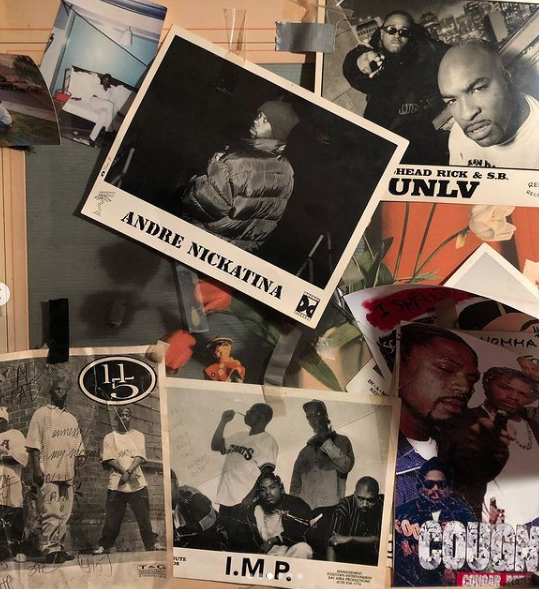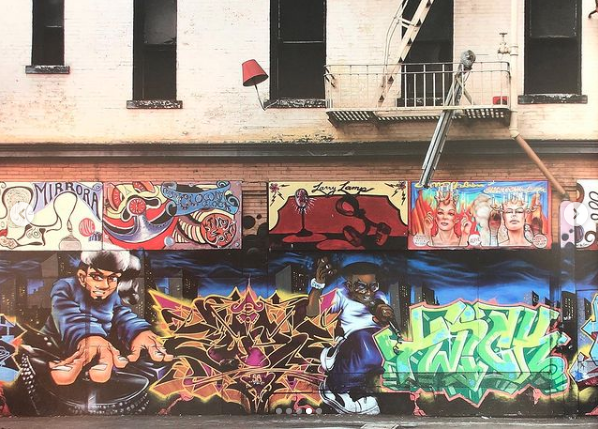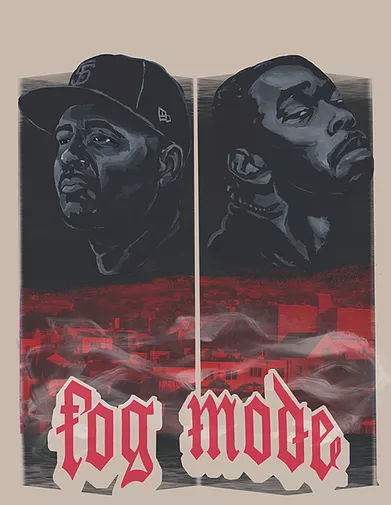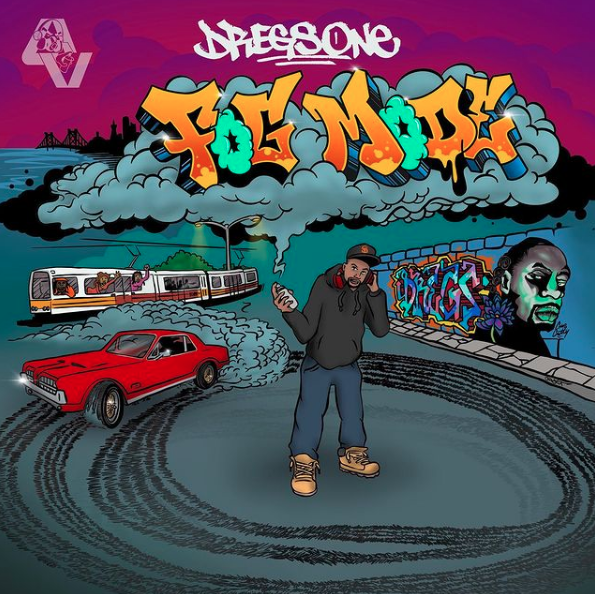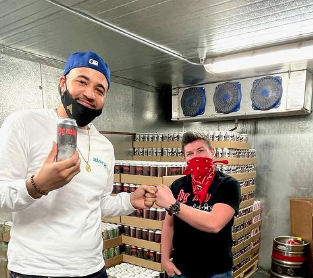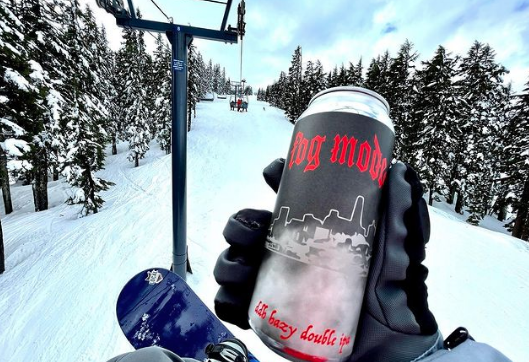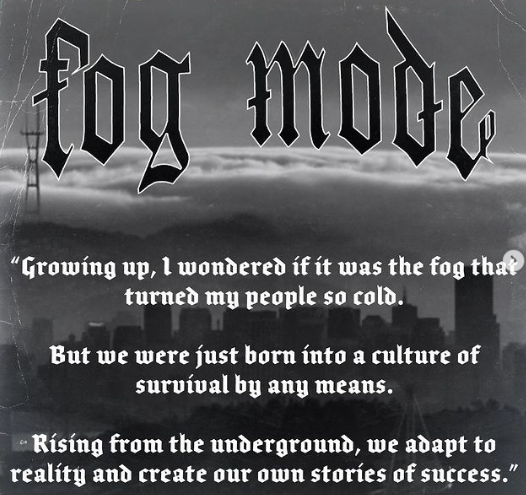Dregs One & Fog Mode: Reclaiming Frisco
Raise your hand if you grew up in the City. Raise your hand if you rock with Roxie’s. Raise your hand if you rolled up to the top of Twin Peaks with your squad just to blaze in the fog. Raise your hand if you sipped Henny before you could legally vote. Depending on where you grew up in the city, we probably have different experiences, but our varying memories are nonetheless precious, as we all collectively watched San Francisco change its face over the last 10 years. The Bay Area is known for having its own bubble of diverse cultures and styles of music, and in the midst of all the changes—most notably gentrification— we have seen more and more conversations on the mass exodus, impacts of whitewashing neighborhoods, and culture vulture antics. In my interview with Dregs One—veteran rapper, artist, and advocate— we take a deeper look at his new track with Andre Nickatina, Fog Mode: the track, the message, the brand— an anthem for those of us holding onto what’s left of the City we know and love. Dregs takes us for a walk in his shoes, through the City as seen from his experiences through graffiti, community, and a lineage of Frisco rap. Not only is Fog Mode an absolute banger, it’s a reminder of the joy we create for ourselves in order to survive the grief of losing this city, piece by piece. I could definitely leave it at the fact that Fog Mode is a great cut by two prominent Bay Area rappers. But let’s dive deeper into Dregs’ vision for Fog Mode as a contribution to the city’s culture, and why its timing is significant for San Francisco.
The City
In order for me to illustrate why Fog Mode is a crucial addition to San Francisco’s cultural fabric, I needed to first grasp how we came to harbor this longing for something organically San Franciscan again: there was a time when there was room for everyone in the city. This isn’t to say that everyone lived in harmony or that everything was perfect, but different pockets of communities were tight-knit and strong. This is part of the cultural fabric and it’s also what draws people to San Francisco. It’s thanks to the people who have (and still do) love and work and live and fight for our communities, to authentically be and thrive in this city, for the last generations and decades and years. ...And gentrification would be the rot that knocks the legs from beneath us, squeezing us out of our own spaces.
Changes caused by gentrification are not limited to out-of-touch tech transplants and out-of-state developers. We see the city’s history of sheisty business transactions, which result in pricing-out residents and local businesses to make room for new incomers who are willing and can afford to buy up space. Major signals and persistent undertows of gentrification include heightened policing, redeveloping neighborhoods, and disappearances of local art in Black and brown neighborhoods. Money puts people in power, and it pushes out those who cannot afford, or fit, the socio-economic expectations of “beautified” neighborhoods. A prime example of literal whitewashing, was the desecration of a Precita Eyes mural in the Mission, illustrating a blatant disregard for the local Latinx community, the youth, local street art culture, and the people whose stories went into the mural. For Dregs, he observed this rough decade of changes within the city, and reflects those changes as a defining theme in his music and art. Dregs notes films like The Last Black Man in San Francisco (2019), and recalls a string of police brutality-related murders of young Black and Brown men, namely Mario Woods and Alex Nieto. We must consider the number of times that whiteness and victimhood are leveraged against Black and Brown people through 911 calls, how these situations are escalated by responding police who have a pattern of racial profiling and excessive force, resulting in fatal outcomes. As we enter a new decade, Dregs observes a post-gentrified city:
Gentrification really hit, where parts of the Mission and parts of the Fillmore were totally changed.. [and] I feel like in 2020, that change has pretty much hit every neighborhood. There's at least one block, or one area, that is affected like that...I think we're [now] living almost in a post-gentrified San Francisco, and with this new year, 2020, starting off with the Coronavirus pandemic, with rents dropping, and a lot of companies and small businesses and restaurants closing their doors... [we’re] starting to see [that] the only people left are natives, or people who genuinely want to be here. And now that we're in this post-gentrified state, we've all accepted the reality of what's happening. A lot of us [have] grown older, and we're thinking of what to do to move forward, and [part of that is] how to really reclaim the space in the most impactful way.
Dregs pinpoints how desolate the city feels, after waves of changes, brought on not only by gentrification, but especially since the pandemic. While “Fog Mode,” as a singular track, is more of a party banger than a social commentary, it still comes from a deeper, shared love for the City, and that’s where the weight of Fog Mode truly sits.
The Track
“Accompanied by the legendary Nickatina, Fog Mode shows Dregs One on a mission through a version of the city that defies the whitewashed image of gentrification. The two lyricists conjure visions only known to the underground subculture of SF, like nights partying on Broadway or hustling in the cuts of 16th and Mission.”
Andre Nikitina is an absolute staple in Bay Area music and culture. What does it mean for you personally to team with Nikitina?
Dregs: It’s pretty big; For people that have known me for a long time, and that grew up with me.. he was always known as the rapper from the City, at least in my generation. That's the first person I heard out here doing it like, Have you ever heard of Dre Dog (Andre Nickatina) though? And I was like, Nah, he's from here? Whoa. And then getting into his music and learning more about what he and Equipto were doing.. So I think for all this time to pass, and being at this stage in my life, where he's at this stage in his career, it's the perfect timing for me to work with him. I think it also signifies a next evolution in my musicianship.. even though my legal career is doing quite well, I want to show people that I can do whatever I want with my music as well. And I feel like this year (2020) has been my most successful year, in 14 years of doing music. This collaboration with Dre is just one of the hallmarks of this year. Everything is lining up right now.
What are some of the key experiences you feel that only San Franciscans would understand?
Dregs: The first thing that jumps out at me is graffiti. There's people who never turned into serious artists or muralists, but they picked up a marker and tagged on a bus. Or if you lived in a town like we grew up in, [you] see what the buses were like. The tunnels were a total art gallery, and for me, I draw inspiration from that. But I think the main thing I draw from San Francisco is, in a loose term, the community of it. Maybe, I gotta go to a job interview Downtown. Then I gotta cash a check in the Mission, and then I gotta meet my friends in the Sunset. And then I gotta go home and do something for my Moms. Throughout that day, I would just run into people— all day, that I knew. And it was just on some like, unexpected thing. There you go, hey what’s up. [It’s about] having access to this network of kids from all over diverse backgrounds, where we're all on the same page with each other. It's like a village within the City that we all belong to. A lot of it is through the public school system, through the buses, just organically building this community together— that still exists! Even though I don't see nobody when I go around the city.. But I know my boy in Hayward with his family where they live now, or my folks that are up in Sac, and we're still representing the same things. It was like a very tight knit village. Now it's like a whole diaspora that spread across the whole West Coast, and even New York. And we're just all spread out now.
How do you define an anthem and why do you feel it's important for the City to have an anthem?
Dregs: I'm the type of artist to make music with too many expectations in mind. But at the end of the day, having a Frisco anthem is very important— culturally. [An anthem] is a measure of how you know you're really [making an impact] as an artist, and when you just know you got one of them ones— I'll be playing this at the barbecue in 20 years. Or when you're at the club—when we used to be at the club— and all of a sudden it's like, Oh, damn, they just played “Bammer Weed!” Like those [tracks], so basically an anthem is something that leaves an imprint for a long time and instantly gives people that feeling of this is us, this is part of us.
Dregs: [Having something] we can identify with is important, especially for us now, because I feel like we don't really get that.. I look at a lot of the other artists—younger and even people in my age range—and for a lot of them, you wouldn't even know they were from San Francisco. It’s dope to switch it up, but at the same time, I feel like it's [removed] from what I grew up around, which is a whole network and community of rappers. You'd see Nickatina and Cougnut and Quinn.. And in a way, they were almost all moving together. Now I see people just going for their own neighborhood or their own set for their own career. So right now, an anthem is good for the city, because we need to know we're all still together in continuing this cultural lineage of making these types of songs that speak to our culture, and keep us alive, you know?
With all this in mind, how did you and Andre Nickatina approach this song?
Dregs: I'm more known for dirty sample, mellow, boom bap type of stuff.. I actually wanted to get him on a Curtis Mayfield sample and I wanted him to just get lyrical and tear up the mic, like you hear on them old Dre Dog tapes. But he wasn't going for any of the beats that initially sent him. When I finally arrived on a beat that he liked, which was produced by Adeyemi, and since I had this Fog Mode idea in my head already… I figured, Well, why not make it big? And since I got Dre, I'll make it the title track, and try to describe everything that Fog Mode represents. [We’ll] make it fun, but also uniquely, almost an education on the city. But it wasn't like, Alright, let me sit down and make a new San Francisco [anthem]. Time will tell. It's doing really well right now. It continues to move upwards, but time will tell if it really is that anthem. I just really wanted to make a slap with Dre Dog, and check that off my music goals.
The Brand
As a brand, “the “Fog Mode” brand, artwork, and musical feel [aim to] reflect the determinative hustle of San Franciscans to preserve their communities and cultural identities against all odds.” What led you to take Fog Mode beyond a track, into a brand?
Dregs: It's more than just marketing.. I'm a rapper, I don't think about marketing when I'm writing a rap or listening to beats. I heard this advice from Boots Riley at the Daly City Bart Station. I always tell this story. He was just telling me, “You have to create your own world. You create your own world and you draw people into it.” And it took me a long time to really understand that. It took me even longer to understand that the opportunity where music lined up with an idea, could create this world.. [And my world is] graffiti, it's all these things that are unknown [in San Francisco].
Dregs: When I posted a throwback picture of me on Muni [from] ten years ago in a black hoodie and a beanie, and graffiti all over the bus.. that tweet blew up on Twitter and Instagram. So it let me know— I have all these old flicks [and footage]; I have all this old knowledge; I have access to people like Nickatina and Quinn and all them; my OG graffiti partners— so Fog Mode became a way for me to really capture all that. The album is all graffiti-inspired. It's creating the same feel. [And on a wider scale], right now, this is my contribution to the culture. This is something I want, like [in the next] five to ten years, people will say, This is Frisco shit, what you know about this? Here, listen to this, and then you'll understand.
Tell me more about the visuals and the artwork.
Dregs: Everything is all about graffiti. That's my lane.. I'm one of the only graffiti writers to really take it to music and go in this direction with it, so I bring all that along with me. And my boy, Max Marttila, coming from the murals scene, graffiti, [now] a professional artist.. I have been working with him all year through my label, Audio Vandals, [and because] he grew up in the city, he understands that vision of what the song means. And [Dino], who is a graff writer, really went hard bombing and doing murals, and who I have collaborated with on a lot of walls, laced me with some drawings for the album cover. So again, how do you create your own world? Everything falls into this theme.. from the artworks, the way I roll it out, to the photographers who understand this mind state. [Fog Mode] is strategically thought out—visually— to go along with the [music], to give you this feeling.
How do you feel about the timing of Fog Mode? Do you feel there is a significance to the roll out of Fog Mode at this time in particular?
Dregs: It's all coming together like fate. I've been sitting on [this project] for two years, almost three by 2021. I've been working on this album with Adeyemi. Why didn't it come out last summer? That's what I had planned, you know what I mean? But I went from 14 tracks to 22, and now it includes this title track and all these other opportunities that have come across this year. And I think, honestly, in a way this is my reward for staying true to my craft even when I went through so many changes in my personal, professional life, and in the world itself. I knew that Fog Mode is a party banger; obviously the parties are shut down right now. But I just believed in the strength of this and because it goes with this foggy late night feeling.. you can hear this summertime, winter time, whenever. December is not the best time to drop music, but this year I just felt confident. This is gonna close out the year. I'm going to sneak this in and surprise everybody, come out of nowhere with this, and then I'm gonna ride this wave for all of 2021. Just keep dropping more merch, more art, more visuals, and more music.
Dregs One recently collaborated with Local Brewing Co. to create the Fog Mode Hazy IPA, which has been distributed all over California:
The Message
For the roll-out of the song, you hosted a virtual listening party. What are some of the challenges for you rolling out a new project during a pandemic?
Dregs: I discovered [that the] sky's the limit at this point. It don't stop. I can't do shows anymore, like I used to, but guess what, no one else can. The scene had been so flooded and so congested and so overexposed, that it [created] a lot of competition for local shows. Now I just do my own thing, whether it's virtual or meet people up at a safe distance, and bam, here's some merch. I'm protected, you're protected, bada bing bada boom… I just had to redefine my hustle.
Dregs: On some real stuff, I feel like music is a gift to people who hear it. I'm getting messages from people, like I'm so glad you're still doing music, you got me through my hardest times of addiction. Wow, that's crazy! And this is a time where everything seems to be going wrong outside, but people need music. I can't curl up in a ball and wait for this all to be over. For other artists and people who chose to sit this one out— I get it. It's totally understandable. For me, though, I just use this analogy: I'm the piano player on the Titanic. World's about to end, everybody about to die? Well, might as well hear some music while we go! [We need it to get] through these crazy times, with some positive messages and positive energy.
(This interview was conducted in December 2020). We’re now two weeks from when you dropped the song, what kind of feedback have you received so far?
Going into week two, the feedback is pretty much universal. As soon as people hear it, they just agree: Yeah, this is a slapper! It’s starting to pick up traction. I'm getting feedback from Japan, New Zealand. A lot of my older [listeners] are coming out the cuts. A lot of new listeners are coming up every day. This is a slapper and I'm getting love from DJs. A lot of people are happy about this song and collaboration, and I'm just getting started. We're shooting the music video on Thursday. There's a remix in the works. I don't want to say who's going to be on it yet, but it's going to be crazy. It's going to be another big book for the city. The response has been incredible.
(The remix was released in January 2021, with Andre Nickatina and featuring Black C and RBL Posse).
What do you want your listeners to take away from the song?
Dregs: Have fun and hustle hard. There's a lot of positive stuff being said on that song if you really [listen]. No, I'm not talking about shooting people or literally selling dope or being the hardest dude ever. I'm talking about taking my lady out to brunch, having fun and driving around, enjoying myself and being on my hustle, and getting in and out of these tough situations. And if you listen to Dre’s verse.. anything in life I wanted to be, I’ma be it. So just have fun, hustle hard and do your thing. And I really hope during New Year's Eve, you know, folks that are having whatever functions in their homes, or wherever, are drinking Hennessy and playing this very loudly.
What do you want people to experience with the Fog Mode brand?
Dregs: I want people to see this world that I'm creating. I want them to step into my shoes, and see this world from my eyes. And [I want them to] understand [that] this is a new experience for Frisco, because what I'm bringing to this album creatively is something that Kendrick did with Good Kid M.A.A.D City. This is like Frisco mob rap from the perspective of a good kid who just grew up in a crazy environment, and has a lot [of knowledge to offer]. I hope I inspire other people and other artists.. you don't have to rap like you’re the hardest dude ever. You don’t have to disrespect women. You can still be on some fly shit, and still be positive and still be yourself. And that's what I hope people ultimately get. Whether they're from San Francisco or not. I hope people relate to finding value in what I experienced and where I grew up. There’s value in my story, and I'm gonna go tell my story, whether it's graffiti, music, or however else. That’s the ultimate message.
As previously mentioned, this interview was conducted in December of 2020. In the months between, the rise of violence against Asian Americans, Asian American women, and elders in particular, across the nation and in San Francisco were extremely difficult to digest. In that time, I also re-interviewed BBoy Whacko regarding bboy spaces, gentrification, and namely the loss of Cellspace in 2014. The compounding grief between the targeted violence and destruction of beloved communal spaces helped me grasp the significance of Fog Mode’s timing as critical hope. To be joyous in this world, is an act of resistance. Dregs embodies so much of the city and what it means to grow up in San Francisco. For a lot of city kids, myself included, the experience of the city defines a part of who we are— it’s a shared knowledge. So when the city flushed out all those pieces that we identify ourselves with, we were forced to bid farewell to a version of home that no longer exists. This, too, is grief. But Dregs has shown us so much of what is possible, pushing forth our narratives, even during a pandemic, and keeping the spirit of the City alive through memory, storytelling, art, and collaboration. Against this backdrop of the city taking away spaces that once belonged to the people, Fog Mode is not only a soundscape that triggers a Hyphy Era happy muscle memory, it’s a capsule of the visualscape we once knew, and it’s here to reclaim the City.
Lastly, raise your fist if you call it FRISCO. I personally don’t care what you call it, as long as you don’t disrespect it. If the Verzuz with E-40 and Too Short has shown us anything— it’s really the Bay Area verzuz the world.
Sources
KALW Local Public Radio. “Whitewashed mural reveals the role street art plays in the survival of the Mission's culture” Article. August 10, 2017.
Fog Mode Press Release (December 2020).
Images from Dregs One Instagram; Local Brewing Co. Instagram
Photo credits @millavellz; @inksoftruth
Recommended Readings
On Alex Nieto: Solnit, Rebecca. “Death by Gentrification: the Killing that Shamed San Francisco.” The Guardian. Article. March 21 2016.
On Mario Woods: KQED Archives
Follow Dregs One


